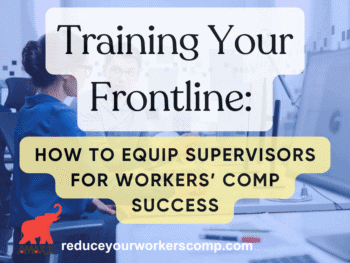
In the prior installment, there was a focus on improving the training provided for an effective injury response, having a better claim investigation process, and collecting the correct data. This installment will focus on consistent reporting systems, better communication, and ensuring the employee receives the proper medical care following a work injury. Taking these steps will improve the process and drive claims toward settlement.
Consistent Injury Reporting Systems
A flaw in many claim reporting systems is the lack of consistency in reporting claims. Many problems occur information is not reported consistently – a garbage in; garbage out concept. Now is the time to review your reporting system and ensure that all information reported is accurate and consistent.
- Manage the entire incident lifecycle: Many systems focus on accurately reporting information at the onset of the claim. Once that occurs, there is no emphasis on the same high standard of reporting information related to a claim. As famed poet Vladimir Nabokov might say, “A (claims professional) should have the precision of a poet” at all phases of adjusting a workers’ compensation claim.
- Improve visibility into incidents of all types: Benign workers’ compensation claims often become nightmares. This occurs when members of the claim management team and other interested stakeholders fail to recognize warning signs or danger. This includes a claim that involves employees with a pattern or claims, undiscovered factors driving litigation, and a general lack of care on claim in-take.
- Identify root causes to reduce risk and prevent recurrence: All interested stakeholders need to be involved in identifying the origins of a work injury and discuss suggestions on how to reduce future incidents. Examples include a pattern of injuries occurring during a specific phase of manufacturing or safety oversites on a work site. It can also include the lack of an ergonomics review in the workplace.
- Easily comply with all regulatory requirements and standards: Employers and insured are often unaware or lack the resources to conduct a complete review of local, state, and federal rules that govern a workplace. Proactive claim team members can assist their clients in identifying these regulations and ensuring they comply. The result will be a reduction in work injuries, a safer work environment, and a reduction in fines and other sanctions.
This post is one in a 2-part series:
Consistency is vital in having a workers’ compensation program grounded in proper fundamentals. Following these items can ensure a complete injury reporting process.
Effective Communication
President Ronald Reagan was often referred to as the “great communicator” for using his acting skills to project confidence and optimism to the American people. In the same way, President Bill Clinton used similar skills to win the election in 1992 by proclaiming, “I feel your pain!” Now is the time for interested stakeholders to channel the former presidents and incorporate communication skills into their best practices.
- Communication with the employee: Keep all communications with employees simple and timely. Prioritize responses to their inquiries promptly and ensure they are presented with just the facts. Failing to communicate with an employee is the main pain point in the workers’ compensation process. Never be judgmental and treat all employees with respect and dignity.
- Communication within the employer: Make it a point to communicate with the employer in the same timely manner as you would the employee. If there is no point of contact within an organization, work directly with the highest level available to find someone to direct all information. Suggest they appoint an injury and/or a return to work coordinator.
- Communication within the claim team: There are many moving parts within a claim team. This can include involvement with a claim handler’s supervisor and team lead. Other vital members include a medical and/or risk director. Make sure all involved team members are provided with accurate and timely information. Never shy away from speaking up when someone is not responding.
Now is the time to become a great communicator in your workers’ compensation program.
Ensure Injured Employees Receive Proper Medical Care
Always ensure the injured employee is provided promptly. Train all supervisors on providing basic first aid and contacting telephone nurse triage services or emergency medical care as appropriate. When in doubt, call 9-1-1!
Conclusions
The fundamentals of a claim program are something that should be reviewed constantly. Working on things discussed in the first installment and this edition is key. When done correctly, the claim team will function in the best manner possible and provide better results for employers and injured employees.

Contact: mstack@reduceyourworkerscomp.com.
Workers’ Comp Roundup Blog: http://blog.reduceyourworkerscomp.com/
©2022 Amaxx LLC. All rights reserved under International Copyright Law.
Do not use this information without independent verification. All state laws vary. You should consult with your insurance broker, attorney, or qualified professional.

















